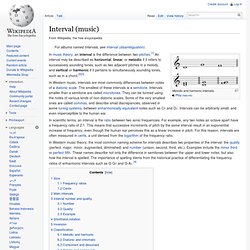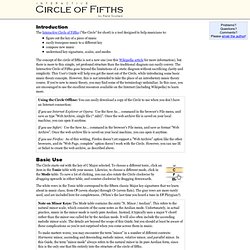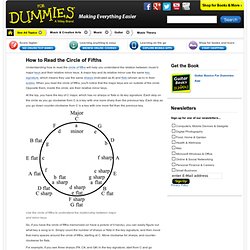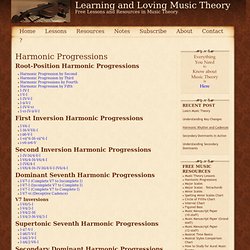

University: Gene Biringer's Home Page Site. Interval (music) Melodic and harmonic intervals.

Play Example: Perfect octave on C in equal temperament and just intonation: 2/1 = 1200 cents. Play The size of an interval (also known as its width or height) can be represented using two alternative and equivalently valid methods, each appropriate to a different context: frequency ratios or cents. The size of an interval between two notes may be measured by the ratio of their frequencies. Mathematically, the size in cents of the interval from frequency f1 to frequency f2 is Main intervals from C. Play In Western music theory, an interval is named according to its number (also called diatonic number) and quality. Perfect Perfect intervals on C. Perfect intervals are so-called because they were traditionally considered perfectly consonant,[10] although in Western classical music the perfect fourth was sometimes regarded as a less than perfect consonance, when its function was contrapuntal.
Major/minor Augmented/diminished Augmented and diminished intervals on C. d2 , Interactive Circle of Fifths User's Guide. The Interactive Circle of Fifths ("the Circle" for short) is a tool designed to help musicians to: figure out the key of a piece of music easily transpose music to a different key compose new music understand key signatures, scales, and modes The concept of the circle of fifths is not a new one (see this Wikipedia article for more information), but there is more to this simple, yet profound structure than the traditional diagram can easily convey.

The Interactive Circle of Fifths goes beyond the limitations of a static diagram without sacrificing clarity and simplicity. This User's Guide will help you get the most out of the Circle, while introducing some basic music theory concepts. However, this is not intended to take the place of an introductory music theory course.
Music Theory. Theory on scales » modes of the major scale » ionian mode / major scale. How to Read the Circle of Fifths. Understanding how to read the circle of fifths will help you understand the relation between music's major keys and their relative minor keys.

A major key and its relative minor use the same key signature, which means they use the same sharps (indicated as #) and flats (shown as b) in their scales. When you read the circle of fifths, you'll notice that the major keys are on outside of the circle. Opposite them, inside the circle, are their relative minor keys. At the top, you have the key of C major, which has no sharps or flats in its key signature. Each stop on the circle as you go clockwise from C is a key with one more sharp than the previous key. Use the circle of fifths to understand the relationship between major and minor keys. So, if you have the circle of fifths memorized (or have a picture of it handy), you can easily figure out what key a song is in. Guitars Glossary 12/8 groove 12-bar blues 7th chord accent accidentals. Teoría - Music Theory Web. The Diatonic Scales. Music Modes. Home » Piano Theory » Music Modes , The story of the musical modes starts in ancient Greece.

The Greeks were the one to name the different modes after ancient Greek subgroups; the Locrians and the Dorians. Phrygia and Lydia were places with non Greek people close by. Later in the 9th century the church modes originated. Theorists took the Greek modes and applied them to their own concept. Musical Scales. Learning and Loving Music Theory. Kelvin, You actually caught a mistake on the roman numerals!

Thanks, I’ll have to fix that. The first and last chords of the progression are not 7th chords. Somehow I inadvertently typed “I7″ on the first chord of all the major keys. (Notice that I didn’t do that for the minor keys.) In the classical tradition, for the sake of stability, the first and last chords of a circle-of-fifths progression are usually triads, not 7th chords. Harmonic Sequences Part 2 In the jazz tradition all chords usually are 7ths, in which case the progression will start and end with 7th chords.
Thanks again for your interest and input. Music Theory - Intervals & Scales. As of July 1, 2013 ThinkQuest has been discontinued.

We would like to thank everyone for being a part of the ThinkQuest global community: Students - For your limitless creativity and innovation, which inspires us all. Teachers - For your passion in guiding students on their quest. Partners - For your unwavering support and evangelism. Parents - For supporting the use of technology not only as an instrument of learning, but as a means of creating knowledge.
We encourage everyone to continue to “Think, Create and Collaborate,” unleashing the power of technology to teach, share, and inspire. Best wishes, The Oracle Education Foundation. Musical Scales.